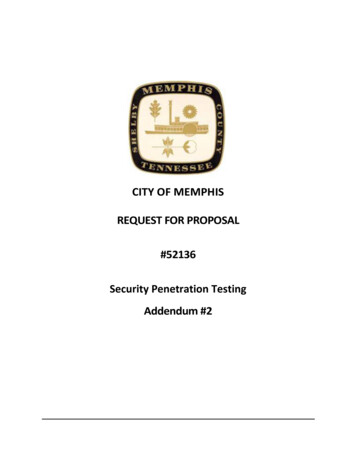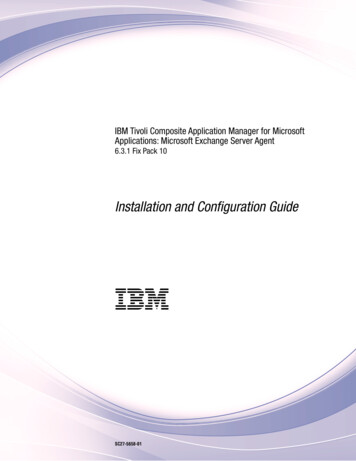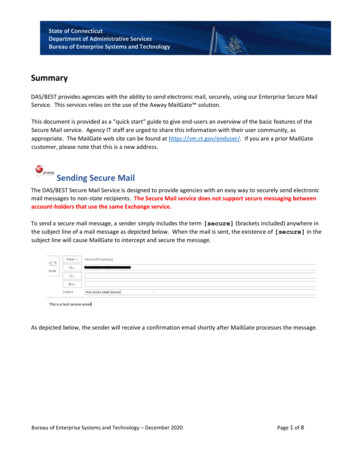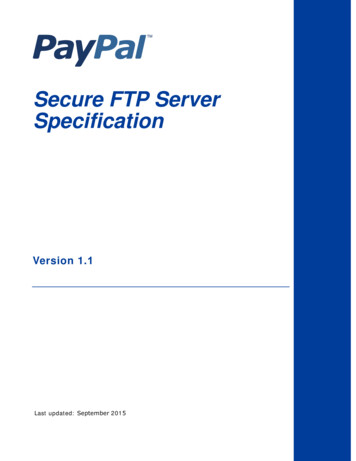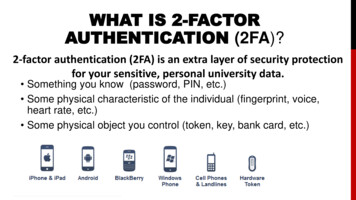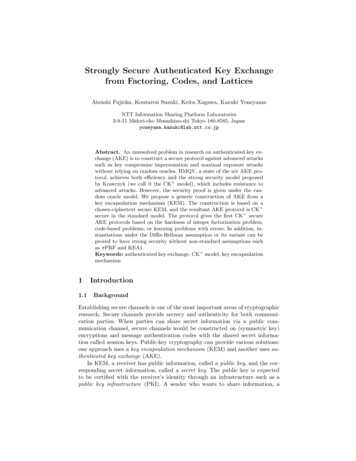
Transcription
Strongly Secure Authenticated Key Exchangefrom Factoring, Codes, and LatticesAtsushi Fujioka, Koutarou Suzuki, Keita Xagawa, Kazuki YoneyamaNTT Information Sharing Platform Laboratories3-9-11 Midori-cho Musashino-shi Tokyo 180-8585, Japanyoneyama.kazuki@lab.ntt.co.jpAbstract. An unresolved problem in research on authenticated key exchange (AKE) is to construct a secure protocol against advanced attackssuch as key compromise impersonation and maximal exposure attackswithout relying on random oracles. HMQV, a state of the art AKE protocol, achieves both efficiency and the strong security model proposedby Krawczyk (we call it the CK model), which includes resistance toadvanced attacks. However, the security proof is given under the random oracle model. We propose a generic construction of AKE from akey encapsulation mechanism (KEM). The construction is based on achosen-ciphertext secure KEM, and the resultant AKE protocol is CK secure in the standard model. The protocol gives the first CK secureAKE protocols based on the hardness of integer factorization problem,code-based problems, or learning problems with errors. In addition, instantiations under the Diffie-Hellman assumption or its variant can beproved to have strong security without non-standard assumptions suchas πPRF and KEA1.Keywords: authenticated key exchange, CK model, key tablishing secure channels is one of the most important areas of cryptographicresearch. Secure channels provide secrecy and authenticity for both communication parties. When parties can share secret information via a public communication channel, secure channels would be constructed on (symmetric key)encryptions and message authentication codes with the shared secret information called session keys. Public-key cryptography can provide various solutions:one approach uses a key encapsulation mechanism (KEM) and another uses authenticated key exchange (AKE).In KEM, a receiver has public information, called a public key, and the corresponding secret information, called a secret key. The public key is expectedto be certified with the receiver’s identity through an infrastructure such as apublic key infrastructure (PKI). A sender who wants to share information, a
session key, with the receiver sends a ciphertext of the information and, thereceiver decrypts the ciphertext to extract the information. KEM can be easilyconstructed from public-key encryption (PKE) under the reasonable conditionthat the plaintext space is sufficiently large. The desirable security notion ofKEM is formulated as the indistinguishability against chosen ciphertext attacks(IND-CCA).In AKE, each party has public information, called a static public key, and thecorresponding secret information, called a static secret key. The static public keyis also expected to be certified with a party’s identity through an infrastructuresuch as PKI. A party who wants to share information with a party exchangesephemeral public keys, generated from the corresponding ephemeral secret keys,and computes a session state from their static public keys, the correspondingstatic secret keys, the exchanged ephemeral public keys, and the correspondingephemeral secret keys. Both parties then derive a session key from these valuesincluding the session state using a function called the key derivation function.Many studies have investigated the security notion of AKE [1–5]. The first security notion of AKE based on indistinguishability was provided by Bellare andRogaway [1] (BR model). The BR model captures basic security requirementsfor AKE such as known key security and impersonation resilience. However, theBR model cannot grasp more complicated situations where a static secret key orsession state of a party has been leaked. Accordingly, Canetti and Krawczyk [2]defined the first security notion of AKE capturing the leakage of static secretkeys and session state and called it the Canetti-Krawczyk (CK) model. Thoughthe CK model represents leakage of information other than the target sessionof the adversary, some advanced attacks such as key compromise impersonation(KCI), the breaking of weak perfect forward secrecy (wPFS) and maximal exposure attacks (MEX) use secret information of the target session; thus, theCK model is not resilient to such attacks. KCI means that when given a staticsecret key, an adversary will try to impersonate some honest party in order tofool the owner of the leaked secret key. wPFS implies that an adversary cannotrecover a session key if the adversary does not modify messages of the targetsession and the session is executed before the static secret keys are compromised. In MEX, an adversary tries to distinguish the session key from a randomvalue under the disclosure of any pair of secret static keys and ephemeral secretkeys of the initiator and the responder in the session except for both the staticand ephemeral secret keys of the initiator or the responder. Resistance to MEXrequires security against any leakage situation that was not presumed. For example, an implementer of AKE may pretend to generate secret keys in an insecurehost machine in order to prevent the randomness generation mechanisms in atamper-proof module such as a smart card. Additionally, if a pseudo-randomnumber generator implemented in a system is poor, secret keys will be knownto the adversary even when the generation of ephemeral secret keys is operatedin a tamper-proof module. Most AKE protocols are proved in the CK model;however, it is unclear whether such protocols satisfy resistance to advanced attacks due to the limitations of the CK model. A state of the art AKE protocol2
HMQV [3] satisfies all known security requirements for AKE, including resistance to KCI, wPFS1 , and MEX, as well as provable security in the CK model.In this paper, we call this security model the CK model; it is known to be oneof the ‘strongest’ models for AKE. LaMacchia et al. [4] and Sarr et al. [5] alsoproposed very strong security models for AKE by re-formulating the concept ofthe CK model; they called them the eCK model and the seCK model, respectively. These models allow an adversary to pose a query that directly reveals theephemeral secret key of the target session. However, Cremers points out that theCK model and the eCK model are incomparable [9, 10]; thus, the eCK model isnot stronger than the CK model while the CK model is. We will briefly showthe difference between the CK model and these models. Since MEX includesany non-trivial leakage situation, HMQV (and CK secure protocols) achievessurprisingly strong security.1.2Motivating ProblemHMQV is one of the most efficient protocols and satisfies one of the strongestsecurity models (i.e., CK security). However, the security proof is given inthe random oracle model (ROM) under a specific number-theoretic assumption(Diffie-Hellman (DH) assumption). Moreover, to prove resistance to MEX, theknowledge-of-exponent assumption (KEA1) [11] (a widely criticized assumptionsuch as [12]) is also necessary. Hence, one of the open problems in research onAKE is to construct a secure scheme in the CK model without relying onrandom oracles under standard assumptions.Boyd et al. [13–15] gave a partial solution to this problem by noting that KEMand AKE are closely related and that it might be natural to construct AKE fromKEM. They proposed a generic construction of AKE from KEM (BCGNP construction), and its security is proved in the CK model in the standard model(StdM). Also, the BCGNP construction is shown to satisfy resistance to KCI.However, it is unclear whether the BCGNP construction is secure when leakage of secret information occurs (i.e., resistance to MEX). In fact, the BCGNPconstruction fails to satisfy CK security when we consider the following attackscenario: Two parties exchange ciphertexts of an IND-CCA secure KEM schemeand generate a session key from these. An adversary who obtains the ephemeralsecret keys (randomness used in generating ciphertexts) of the parties can compute the session key and win the game. Though the BCGNP construction canbe extended to satisfy wPFS, it is guaranteed under the DH assumption, not ageneral assumption. It is quite restrictive because it cannot be instantiated from1HMQV does not provide full perfect forward secrecy (fPFS), which is the same aswPFS except that the adversary can modify messages of the target session. Someschemes [6–8] have achieved fPFS. However, the schemes [6, 7] are clearly vulnerableto MEX; that is, the session key is computable if an adversary obtains an ephemeralsecret key of parties in the target session. The other scheme [8] is resilient to MEX,but security is proved in the random oracle model. Upgrading wPFS to fPFS is notthat difficult; it can be done by simply adding MAC or a signature of ephemeralpublic keys. Thus, we do not discuss fPFS in this paper.3
the hardness of something other than the DH assumption such as an integerfactoring problem, code-based problem, or lattice problem. Thus, we still haveno AKE protocol that is secure in the ‘strongest’ model under just a generalassumption without relying on random oracles (ROs).1.3Our ContributionWe fully solve the open problem by providing a generic construction of AKEfrom KEM. Our construction is a generalization of the BCGNP construction.The BCGNP construction uses IND-CCA KEM, a strong randomness extractor, and a pseudo-random function (PRF) as building blocks. Our constructioneffectively follows the design principle of the BCGNP construction. However, wefirst point out that the security proof of the BCGNP construction is not complete. Specifically, a requirement for KEM has not been formulated. KEM keysmust have enough min-entropy in order to make outputs of the strong randomness extractor statistically indistinguishable from a uniformly random chosenelement. Thus, the assumption that the KEM scheme satisfies such a propertyis additionally required. Fortunately, almost all IND-CCA KEM schemes satisfythat. Also, we need an IND-CPA secure KEM in addition to the BCGNP construction. Such an additional KEM can make our scheme wPFS and resilient toMEX. The resultant AKE protocol is CK secure. Its security is proved underthe existence of such KEMs, a strong randomness extractor, and a PRF in theStdM. The existence of an IND-CCA secure KEM has been shown from thehardness of integer factoring [16, 17], a code-based problem [18, 19], or a latticeproblem [20–26]. To the best of our knowledge, our generic construction providesthe first CK secure AKE protocols based on the hardness of the above problems. Regarding the DH assumption or its variant, our generic construction isthe first protocol that achieves CK security in the StdM without non-standardassumptions (e.g., πPRF and KEA1).We also rewrite the CK model before proving the security of our genericconstruction in order to simplify the original model in [3]. Specifically, the original model is defined as a mix of four definitions (i.e., the CK model, wPFS, andresistance to KCI and MEX); thus, the security proof must also be separatedinto four theorems, which may reduce the readability. Therefore, we reformulatethe CK model as follows: wPFS, resistance to KCI, and resistance to MEX areintegrated into the experiment of the extended model by exhaustively classifying leakage patterns. This definition is handy to prove security and rigourouslycaptures all required properties.We summarize our contributions as follows:– We propose a two-pass generic CK secure AKE construction from INDCCA secure KEM and PRF in the StdM.– We achieve the first CK secure AKE protocols based on the hardness of integer factorization problem, code-based problem, and lattice-based problemin the StdM.– We achieve the first CK secure AKE protocol based on the DH assumptionor its variant in the StdM without knowledge assumptions.4
– We reformulate the CK model to gain readability of the security proof.The proposed generic construction can allow a hybrid instantiation; that is, theinitiator and the responder can use different KEMs under different assumptions.For example, the initiator uses a factoring-based KEM while the responder usesa lattice-based KEM.2Security ModelIn this section, we recall the CK model that was introduced by [3]. We show amodel specified to two pass protocols for simplicity. It can be trivially extendedto any round protocol.2.1CK vs. eCKAs indicated in Table 1, the CK model captures all non-trivial patterns ofleakage of static and ephemeral secret keys. The eCK model [4], which is avariant of the CK model [2], also captures all non-trivial patterns of leakage, asin Table 1. Since the CK model captures all non-trivial patterns of leakage ofstatic and ephemeral secret keys, the CK model can theoretically be seen as acompletion of the AKE security model.In Table 1, the six cases in Definition 2 are listed, and these six cases coverwPFS, resistance to KCI, and MEX as follows: Cases 2-(a), 2-(c), and 2-(f)capture KCI, since the adversary obtains the static secret key of one party andthe ephemeral secret key of the other party of the test session. Case 2-(e) captureswPFS, since the adversary obtains the static secret keys of both parties of thetest session. Cases 2-(b) and 2-(d) capture MEX, since the adversary obtains theephemeral secret keys of both parties of the test session.The main difference between the CK model and the eCK model is that the CK model captures the session state reveal attack, but the eCK model doesnot. Thus, we adopt the CK model, which is stronger than the eCK modelfrom the viewpoint of the session state reveal attack, in this paper.Notice that the timing of the static and ephemeral key reveal differs in theeCK and CK models. In the eCK model, an adversary can issue the staticand ephemeral key reveal query adaptively. In contrast, in the CK model, anadversary can issue a corrupt query to obtain the static key, and the ephemeralkey is given to the adversary when it is determined. We summarize this inTable 2.2.2CK Security ModelWe denote a party by Ui , and party Ui and other parties are modeled as probabilistic polynomial-time (PPT) Turing machines w.r.t. security parameter κ. Forparty Ui , we denote static secret (public) key by si (Si ) and ephemeral secret5
Table 1. Classification of attacks and proposed CK model [3] and eCK model [4].Cases in Def.2 sskA2-(a)r2-(b)ok2-(c)r2-(d)ok2-(e)r2-(f)okeskA sskB eskB attack type CK l [3] eCK model [4]XXXXXXXXXXXX“2-(*)” means the corresponding case in Definition 2. “sskA ” means the staticsecret key of owner A of test session sid , and “sskB ” means the static secretkey of peer B of test session sid . “eskA ” means the ephemeral secret key oftest session sid , and “eskB ” means the ephemeral secret key of the matchingsession sid . “ok” means the secret key is not revealed, “r” means the secretkey may be revealed, and “n” means no matching session exists. A X meansthat the model captures the attack.Table 2. Comparison of CK model [3] and eCK model [4].CK model [3] eCK model [4]All non-trivial key leakageXXSession state revealXχAdaptive key leakageχXA X/χ means that the model does/does not capture the attack.(public) key by xi (Xi ). Party Ui generates its own keys, si and Si , and thestatic public key Si is linked with Ui ’s identity in some systems like PKI.2Session. An invocation of a protocol is called a session. Session activation isdone by an incoming message of the forms (Π, I, UA , UB ) or (Π, R, UB , UA , XA ),where we equate Π with a protocol identifier, I and R with role identifiers, andUA and UB with user identifiers. If UA is activated with (Π, I, UA , UB ), thenUA is called the session initiator. If UB is activated with (Π, R, UB , UA , XA ),then UB is called the session responder. The initiator UA outputs XA , thenmay receive an incoming message of the forms (Π, I, UA , UB , XA , XB ) from theresponder UB , UA then computes the session key SK if UA received the message.On the contrary, the responder UB outputs XB , and computes the session keySK.If UA is the initiator of a session, the session is identified by sid (Π, I, UA , UB ,XA ) or sid (Π, I, UA , UB , XA , XB ). If UB is the responder of a session, the ses2Static public keys must be known to both parties in advance. They can be obtainedby exchanging them before starting the protocol or by receiving them from a certificate authority. This situation is common for all PKI-based AKE schemes.6
sion is identified by sid (Π, R, UB , UA , XA , XB ). We say that UA is the ownerof session sid, if the third coordinate of session sid is UA . We say that UA is thepeer of session sid, if the fourth coordinate of session sid is UA . We say that asession is completed if its owner computes the session key. The matching sessionof (Π, I, UA , UB , XA , XB ) is session (Π, R, UB , UA , XA , XB ) and vice versa.Adversary. The adversary A, which is modeled as a probabilistic polynomialtime Turing machine, controls all communications between parties includingsession activation by performing the following adversary query.– Send(message): The message has one of the following forms: (Π, I, UA , UB ),(Π, R, UB , UA , XA ), or (Π, I, UA , UB , XA , XB ). The adversary A obtains theresponse from the party.To capture leakage of secret information, the adversary A is allowed to issuethe following queries.– SessionKeyReveal(sid): The adversary A obtains the session key SK for thesession sid if the session is completed.– SessionStateReveal(sid): The adversary A obtains the session state of theowner of session sid if the session is not completed (the session key is notestablished yet). The session state includes all ephemeral secret keys andintermediate computation results except for immediately erased informationbut does not include the static secret key.– Corrupt(Ui ): This query allows the adversary A to obtain all information ofthe party Ui . If a party is corrupted by a Corrupt(Ui , Si ) query issued by theadversary A, then we call the party Ui dishonest. If not, we call the partyhonest.Freshness. For the security definition, we need the notion of freshness.Definition 1 (Freshness). Let sid (Π, I, UA , UB , XA , XB ) or (Π, R, UA , UB ,XB , XA ) be a completed session between honest users UA and UB . If the matching session exists, then let sid be the matching session of sid . We say sessionsid is fresh if none of the following conditions hold:1. The adversary A issues SessionKeyReveal(sid ), or SessionKeyReveal(sid ) ifsid exists,2. sid exists and the adversary A makes either of the following queries– SessionStateReveal(sid ) or SessionStateReveal(sid ),3. sid does not exist and the adversary A makes the following query– SessionStateReveal(sid ).7
Security Experiment. For the security definition, we consider the followingsecurity experiment. Initially, the adversary A is given a set of honest users andmakes any sequence of the queries described above. During the experiment, theadversary A makes the following query.– Test(sid ): Here, sid must be a fresh session. Select random bit b U {0, 1},and return the session key held by sid if b 0, and return a random key ifb 1.The experiment continues until the adversary A makes a guess b0 . The adversary A wins the game if the test session sid is still fresh and if the guess ofthe adversary A is correct, i.e., b0 b. The advantage of the adversary A in theAKE experiment with the PKI-based AKE protocol Π is defined as1AdvAKE(A) Pr[A wins] .Π2We define the security as follows.Definition 2 (Security). We say that a PKI-based AKE protocol Π is securein the CK model if the following conditions hold:1. If two honest parties complete matching sessions, then, except with negligibleprobability, they both compute the same session key.(A) is negligible in security2. For any PPT bounded adversary A, AdvAKEΠparameter κ for the test session sid ,(a) if sid does not exist, and the static secret key of the owner of sid isgiven to A.(b) if sid does not exist, and the ephemeral secret key of sid is given to A.(c) if sid exists, and the static secret key of the owner of sid and theephemeral secret key of sid are given to A.(d) if sid exists, and the ephemeral secret key of sid and the ephemeralsecret key of sid are given to A.(e) if sid exists, and the static secret key of the owner of sid and the staticsecret key of the peer of sid are given to A.(f ) if sid exists, and the ephemeral secret key of sid and the static secretkey of the peer of sid are given to A.Note that the items 2.a, 2.c, and 2.f correspond to resistance to KCI, item 2.ecorresponds to wPFS, and items 2.b and 2.d correspond to resistance to MEX.3Generic AKE Construction from KEM withoutRandom OraclesIn this section, we propose a generic construction of CK -secure AKE fromKEM.8
3.1PreliminariesSecurity Notions of KEM Schemes. Here, we recall the definition of INDCCA and IND-CPA security for KEM, and min-entropy of KEM keys as follows.Definition 3 (Model for KEM Schemes). A KEM scheme consists of thefollowing 3-tuple (KeyGen, EnCap, DeCap):(ek , dk ) KeyGen(1κ , rg ) : a key generation algorithm which on inputs 1κand rg RS G , where κ is the security parameter and RS G is a randomnessspace, outputs a pair of keys (ek , dk ).(K, CT ) EnCapek (re ) : an encryption algorithm which takes as inputs encapsulation key ek and re RS E , outputs session key K KS and ciphertextCT CS, where RS E is a randomness space, KS is a session key space,and CS is a ciphertext space.K DeCapdk (CT ) : a decryption algorithm which takes as inputs decapsulation key dk and ciphertext CT CS, and outputs session key K KS.Definition 4 (IND-CCA and IND-CPA Security for KEM). A KEMscheme is IND-CCA-secure for KEM if the following property holds for security parameter κ; For any PPT adversary A (A1 , A2 ), Advind cca DO(dk,·) Pr[rg RS G ; (ek, dk) KeyGen(1κ , rg ); (state) A1(ek); b {0, 1};DO(dk,·) 0re RS E ; (K0 , CT0 ) EnCapek (re ); K1 K; b A2(ek, (Kb , CT0 ),0state); b b] 1/2 negl, where DO is the decryption oracle, K is the spaceof session key and state is state information that A wants to preserve from A1to A2 . A cannot submit the ciphertext CT CT0 to DO.We say a KEM scheme is IND-CPA-secure for KEM if A does not accessDO.Definition 5 (Min-Entropy of KEM Key). A KEM scheme is k-min-entropyKEM if for any ek, for distribution DKS of variable K defined by (K, CT ) EnCapek (re ) and random re RS E , H (DKS ) k holds, where H denotesmin-entropy.Security Notions of Randomness Extractor and Pseudo-Random Function. Let Ext : S X Y be a function with finite seed space S, finite domainX, and finite range Y .Definition 6 (Strong Randomness Extractor). We say that function Ext isa strong randomness extractor, if for any distribution DX over X with H (DX ) k, ((US , Ext(US , DX )), (US , UY )) negl holds, where both US in (US , Ext(US ,DX )) denotes the same random variable, denotes statistical distance, US , UX , UYdenotes uniform distribution over S, X, Y respectively, X n k, Y k,and S d.Let κ be a security parameter and F {Fκ : Domκ F S κ Rngκ }κ bea function family with a family of domains {Domκ }κ , a family of key spaces{FSκ }κ and a family of ranges {Rngκ }κ .9
Definition 7 (Pseudo-Random Function). We say that function family F {Fκ }κ is the PRF family, if for any PPT distinguisher D, Advprf Pr[DFκ (·) 1] Pr[DRFκ (·) 1] negl, where RFκ : Domκ Rngκ is a truly randomfunction.3.2ConstructionOur construction (GC) is based on an IND-CCA secure KEM, an IND-CPAsecure KEM, PRFs, and strong randomness extractors. While the requirementsfor the underlying building blocks are not stronger than those for the previousgeneric construction [13, 14], GC achieves stronger security (i.e., CK security)without random oracles.Necessity of Min-Entropy of KEM Key. In the BCGNP construction, aKEM scheme is only assumed to be IND-CCA. However, it is not enough toprove the security. Both parties derive the session key by applying decapsulatedKEM keys to a strong randomness extractor before applying them to PRFs.This extractor guarantees to output a statistically indistinguishable value froma uniform randomly chosen element from the same space. It requires as input aseed and a KEM key with min-entropy κ, where κ is a security parameter. INDCCA states that no PPT adversary can distinguish the KEM key from a randomelement, but this is “only” computational indistinguishability. What we need isstatistical indistinguishability. Thus, we must also assume that min-entropy ofthe KEM key is equal or larger than κ. This property is not very strong; almostall IND-CCA secure schemes satisfy it. We will discuss later about this propertyof concrete KEM schemes.Design Principle. The main ideas to achieve CK security are to use thetwisted PRF trick and session-specific key generation.First, we have to consider resistance to MEX. The most awkward patternof MEX is the disclosure of ephemeral secret keys of the initiator and the responder. If we use KEM naturally, all randomness used to generate ciphertextsis leaked as ephemeral secret keys; thus, the adversary can obtain encryptedmessages without knowing secret keys. Hence, we have to avoid using ephemeralsecret keys as randomness of KEM directly. A possible solution is to generaterandomness from the static secret key as well as the ephemeral secret key byusing a technique such as the ordinary NAXOS trick [4]. Though this trick leadsto security against leakage of ephemeral secret keys, the trick must apply an ROto the concatenation of the static and ephemeral secret keys, and it uses the output as a quasi-ephemeral secret key. It is unsuitable for our purpose to constructsecure protocols in the StdM. Thus, we use a trick to achieve the same properties as the NAXOS trick but without ROs. We call it the twisted PRF trick.3This trick uses two PRFs (F, F 0 ) with reversing keys; we choose two ephemeral3A similar trick is used in the Okamoto AKE scheme [27].10
keys (r, r0 ) and compute Fσ (r) Fr00 (σ), where σ is the static secret key. Thetwisted PRF trick is especially effective in the following two scenarios: leakageof both ephemeral secret keys of the initiator and the responder, and leakage ofthe static secret key of the initiator and the ephemeral secret key of the responder (i.e., corresponding to KCI). If (r, r0 ) is leaked, Fσ (r) cannot be computedwithout knowing σ. Similarly, if σ is leaked, Fr00 (σ) cannot be computed withoutknowing r0 . In our KEM-based generic construction, the output of the twistedPRF is used as randomness for the encapsulation algorithm.Next, we have to consider the scenario in which static secret keys are leakedas the attack scenario in wPFS. We cannot achieve a CK secure scheme byany combination of KEMs using static secret keys as decapsulation keys againstleakage of both static secret keys of the initiator and the responder because anadversary can obtain all information the parties can obtain by using static secretkeys. Our solution is to generate session-specific decapsulation and encapsulationkeys. The initiator sends the temporary encapsulation key to the responder, theresponder encapsulates a KEM key with the temporary encapsulation key, andthe initiator decapsulates the ciphertext. Since this procedure does not dependon the static secret keys, the KEM key is hidden even if both static secret keysof the initiator and the responder are leaked. Note that security of KEM fortemporary use only requires IND-CPA. The session-specific key generation iseffective for achieving wPFS.As the BCGNP construction [13, 14], we use IND-CCA secure KEM schemesto exchange ciphertexts. CCA security is necessary to simulate SessionStateRevealqueries in the security proof. When we prove security in the case where ephemeralsecret keys are leaked, the simulator needs to embed the challenge ciphertext inthe ephemeral public key in the test session. Then, the static secret key to decrypt the challenge ciphertext is not known; that is, the simulator must respondto the SessionStateReveal query for a session owned by the same parties as thetest session without knowing the static secret key. Hence, the simulator needsthe power of the decryption oracle to obtain intermediate computation resultscorresponding to the SessionStateReveal query.Generic Construction GC. The protocol of GC from KEMs (KeyGen, EnCap,DeCap) and (wKeyGen, wEnCap, wDeCap) is as follows.Public Parameters. Let κ be the security parameter, F : {0, 1} F S RS E ,F 0 : {0, 1} FS RS E , and G : {0, 1} FS {0, 1}κ be pseudo-randomfunctions, where FS is the key space of PRFs ( FS κ), RS E is the randomness space of encapsulation algorithms, and RS G is the randomness space of keygeneration algorithms, and let Ext : SS KS FS be a strong randomnessextractor with randomly chosen seed s SS, where SS is the seed space andKS is the KEM key space. These are provided as some of the public parameters.Secret and Public Keys. Party UI randomly selects σI FS and rI RS G , andruns the key generation algorithm (ekI,1 , dkI,1 ) KeyGen(1κ , rI ), where RS G11
is the randomness space of KeyGen. Party UI ’s static secret and public keys are((dkI,1 , σI ), ekI,1 ).Key Exchange. Party UA with secret and public keys ((dkA,1 , σA ), ekA,1 ), andwho is the initiator, and party UB with secret and public keys ((dkB,1 , σB ), ekB,1 ),and who is the responder, perform the following two-pass key exchange protocol.01. Party UA randomly chooses ephemeral secret keys rA,1 , rA,1 FS andrA,2 RS G . Party UA computes (CTA,1 , KA,1 ) EnCapekB,1 (FσA (rA,1 ) Fr00 (σA )) and (ekA,2 , dkA,2 ) wKeyGen(1κ , rA,2 ) and sen
from Factoring, Codes, and Lattices Atsushi Fujioka, Koutarou Suzuki, Keita Xagawa, Kazuki Yoneyama . however, it is unclear whether such protocols satisfy resistance to advanced at-tacks due to the limitations of the CK model. A state of the art AKE protocol 2. HMQV [3] satis es all known security requirements for AKE, including resis- .

